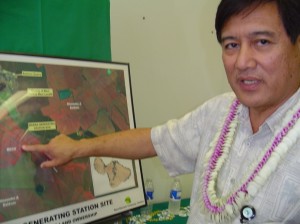Maui Electric Seeks 9.7% Rate Increase
Maui Electric Company is requesting a rate increase for Maui County customers in 2010. The 9.7% increase translates to $28.2 million. The funds generated are projected for use toward capital improvement projects and increased operating and maintenance costs.
If the full request is approved by the PUC, a typical residential home on Maui would see a $13.43 per month increase for a total bill of $172.46. That is reflective of 600 kwh monthly use. On Lanai, (500 kwh per month), the likely increase would be $14.61 per month for a total bill of $181.80. And on Molokai, (500 kwh per month), the likely increase would be $13.65 per month for a total bill of $172.69.
If approved, the earliest anticipated time frame for the increase to take affect is mid-2010. MECO’s last rate increase of 3.7% was received in December 2007. Company officials say the 2007 increase was the first in nearly nine years.
Company Predient Ed Reinhardt acknowledged the challenging times, but said MECO must also make investments for service reliability. “We’ve made concerted efforts to contain costs and improve efficiency, but we must also make the investments to fulfill our responsibility to provide reliable service to our customers,” said Reinhardt. “A strong electric grid is also the backbone needed to support the integration of even greater amounts of renewable energy for our customers,” said Reinhardt.
FUNDS PROPOSED FOR CIP PROJECTS AND SERVICE RELIABILITY
Company officials say the increase would cover more than $122 million in new capital projects to improve service reliability including the installation of a new photovoltaic system at the Kahului Baseyard, and the replacement of control systems at generating units in Maalaea. Â The company released the following list of major projects on their radar:
- Replacement and upgrade of power plant control systems for Maalaea Generating units M17 and M19.
- Installation of a new 100-kW photovoltaic system at MECO’s Kahului Baseyard to incorporate solar energy into MECO’s facilities.
- New or expanded substations to support past and future growth and improve service
- Replacement and upgrade of underground lines to improve service reliability
- Investments in transformers, poles, meters and other facilities to maintain reliable service and fulfill new service requests from customers.
MECO’s requested increase would also cover costs for more frequent inspections of utility poles and lines and increased tree trimming around power lines for greater reliability and more extensive servicing of generating units to maintain efficiency.
The proposal also includes a lower depreciation expense which incorporates new proposed depreciation rates that distribute recovery of the cost of capital assets over a longer period of time.
MOVE TOWARD RENEWABLE GENERATION
As part of an energy agreement signed under the Hawaii Clean Energy Initiative, Maui Electric, Hawaiian Electric and Hawaii Electric Light Company agreed, along with Governor Linda Lingle, the State of Hawaii Consumer Advocate, and the State Department of Business, Economic Development and Tourism, to pursue a new regulatory model called “decoupling,” that would de-link the earning of revenues from electricity usage.
“This could be a game changer that sets a new environment for us to work even more with our customers to help them use energy efficiently and to use more renewable sources,” said Reinhardt. Company officials say the level of revenues set in the rate case, could be used to set the base starting point for decoupling. The PUC is evaluating the details of the decoupling model in a separate docket.
Company officials say the decoupling model could move the utility away from earning revenues based on the amount of electricity sold and instead encourage the utility to help its customers use less electricity and install more distributed renewable generation.
PUBLIC HEARINGS PART OF PUC REVIEW
The PUC is expected to hold a public hearing on the proposed 2010 increase in the next few months and an evidentiary hearing in mid-2010. The PUC may grant an interim increase within 10 to 11 months following the application, but the PUC is not obligated to do so. The timing and amount of any final increase is up to the discretion of the Public Utilities Commission.
(Posted by Wendy Osher; Information Provided by Maui Electric Company)











